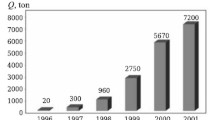Conclusions
The calculation of the thermodynamic parameters showed that in the case of a finely dispersed binding part of the concretes working in conditions where alternating oxidizing and reducing gas media are in operation, the most promising materials are binders based on corundum and high-alumina cement. These data are in good agreement with the results of experimental studies of the carbon-resistance and erosion resistance of a series of refractories. It is also shown that the most effective filler of the concretes is corundum which has a high stability in relation to reducing media and a low vapor pressure a high temperatures.
Similar content being viewed by others
Literature cited
N. V. Pitak, in: Formation of Refractories and Their Service [in Russian], Metallurgiya, Moscow (1984), pp. 42–46.
N. M. Buslovich and L. P. Mikhailov, Lining Materials for Electric Furnaces with a Controlled Atmosphere [in Russian], Énergiya, Moscow (1975).
P. P. Budnikov, New Ceramics [in Russian], Stroiizdat, Moscow (1969).
K. E. Wicks and F. E. Bloch, Thermodynamic Properties of 65 Elements, their Oxides, Halides, Carbides, and Nitrides [translation from English], Metallurgiya, Moscow (1965).
Ya. I. Gerasimov (ed.), Course in Physical Chemistry [in Russian], Vol. 1, 2nd ed., Khimiya, Moscow (1969).
A. A. Zhukovitskii and L. A. Shvartsman, Physical Chemistry [in Russian], 2nd Ed., Metallurgiya, Moscow (1968).
M. Kh. Karapet'yants and M. L. Karapet'yants, Fundamental Thermodynamic Constants of Inorganic and Organic Substances [in Russian], Khimiya, Moscow (1968).
M. Kh. Karapet'yants, Chemical Thermodynamics, 2nd Edition (with revisions and additions), State Scientific-Technical Publishing House of Chemical Literature, Moscow-Leningrad (1953), pp. 61–62.
V. P. Grushko (ed.), The Thermal Constants of Substances [in Russian], Izd. Akad. Nauk SSSR, Moscow, No. 5 (1971); No. 6 (1972); No. 7 (1974); No. 9, (1979).
H. H. Hueisen, J. Chem. Phys., No. 21, 1836–1839 (1953).
R. A. Robie, B. S. Hemingway, and J. R. Fisher, “Thermodynamic Properties of Minerals and Related Substances at 298.15°K and 1 Bar (105 Pa) Pressure and at Higher Temperatures, Government Geological Survey Bulletin, No. 1452, Washington (1978).
I. S. Kainarskii, É. V. Degtyareva, and I. G. Orlova, Corundum Refractories and Ceramics [in Russian], Metallurgiya, Moscow (1981).
G. N. Kozhevnikov and A. G. Vodop'yanov, The Lower Oxides of Silicon and Aluminum in Electrometallurgy [in Russian], Nauka, Moscow (1977).
S. Yamaguchi, Chem. Abstr.,45, 4111–4119 (1951).
N. E. Filonenko, I. V. Lavrov, O. V. Andreeva, and R. L. Pevzner, Dokl. Akad. Nauk SSSR,115, No. 3, 583–585 (1957).
Zh. L. Vert, M. V. Kamenev, and M. I. Sokhor, Dokl. Akad. Nauk SSSR,116, No. 5, 834–836 (1957).
M. Hoch and H. L. Jonston, J. Am. Chem. Soc.,76, No. 9, 2560–2564 (1954).
L. V. Gurvich, G. V. Karachevtsev, V. N. Kondrat'ev, et al., in: Bond Energies of the Chemical Bonds. Ionization Potential and Electron Affinity [in Russian], Nauka, Moscow (1974).
R. R. Venner, Thermochemical Calculations [in Russian], Inizdat, Moscow (1950).
M. S. Kulikov, Thermal Dissociation of Compounds [in Russian], Metallurgiya, Moscow (1969).
S. I. Yakovlev, N. V. Bol'shakova, A. V. Bizina, et al. Ogneupory, No. 6, 15–18 (1984).
P. P. Budnikov and L. B. Khoroshavin, Refractory Concretes in Phosphate Binders [in Russian], Metallurgiya, Moscow (1971).
K. K. Strelov, Structure and Properties of Refractories [in Russian], 2nd Edition (revised), Metallurgiya, Moscow (1982).
A. S. Berezhnoi, Ogneupory, No. 1, 7–13 (1953).
D. H. Huble, Am. Ceram. Soc. Bull.,343, No. 7, 506–511 (1964).
T. Busby and M. Carter, Glass Technol.,9, No. 6, 154–157 (1968).
P. S. Mamykin, Dokl. Akad. Nauk SSSR,60, No. 2, 255 (1948).
N. V. Pitak, Z. D. Zhukova, and V. K. Bocharov, Theoretical and Technological Studies in the Field of Refractories; Collected Works of the Ukrainian Scientific-Research Institute of Refractories [in Russian], No. 10, Metallurgiya, Moscow (1967), pp. 39–42.
Z. D. Zhukova, N. V. Pitak, and V. G. Éntin, Ogneupory, No. 9, 26–32 (1965).
I. G. Orlova, N. L. P'yanykh, and I. S. Kainarskii, Ogneupory, No. 5, 36–44 (1974).
Author information
Authors and Affiliations
Additional information
Translated from Ogneupory, No. 12, pp. 9–16, December, 1986.
Rights and permissions
About this article
Cite this article
Usatikov, I.F., Gal'chenko, T.G., Degtyareva, É.V. et al. Choice of a composition for a high-refractory concrete using calculations of the reduction reaction of the components. Refractories 27, 672–680 (1986). https://doi.org/10.1007/BF01387227
Issue Date:
DOI: https://doi.org/10.1007/BF01387227




